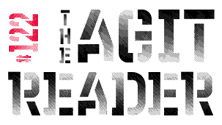
by Kevin Cummins
Rizzoli
There’s the old adage that a picture is worth a thousand words, but that cliche doesn’t always ring true, especially in these days of pixelated images taken on cell phones being uploaded directly to the net. Indeed, in our current accelerated information age, where videos and photos of even the most obscure events are almost instantaneous but inevitably of a sub-par quality, visual imagery has begun to mean less and less, becoming just a constant barrage of stimuli as disposable as it is accessible.
As such, the photographs that Kevin Cummins, a longtime NME photographer and perhaps the premier photo-documentarian of the Manchester music scene of the ’70s and ’80s, took of Joy Division are all the more valuable. That the band only existed for three short years—coming to an abrupt end in 1980 when singer Ian Curtis took his own life just two days before the band’s scheduled departure for their first American tour—makes the photographs he took all the more appreciable.
As Cummins notes in the simply titled Joy Division, a handsome new book collecting his shots of the band recently published by Rizzoli, given the simple economics of how much he was paid by NME and how much it cost to process his photographs, he only took two rolls of film with him when he went on the photo shoot in 1979 that produced what have become the iconic images of the band. Thus, he shot sparingly, not wanting to waste a single frame.
Those images, taken on a snow-covered highway overpass in Manchester, hearken to the music that Joy Division created on the two studio albums, Unknown Pleasures and Closer, that the band recorded during its brief existence. Shot in black-and-white, which Cummins recalls would become the norm for any published images of the band (try imagining Ian Curtis in color—impossible!), the photographs’ sharp contrast echoes the harsh relief of the band’s output, while Manchester’s dim landscape is as modern and bleak as its sonic output. One can almost hear songs like “Isolation” and “Atmosphere” just looking at these images. Moreover, there is none of the slick styling characteristic of glossy music mag shoots; the four band members could just as well be a group of entry-level accountants as the post-punk legends they would become.
Just as stunning are Cummins’ shots of Joy Division rehearsing upstairs at TJ’s Davidson’s (a pub) the same year. The space’s large windows allowed him to work with greater subtleties of light and shadow, and the individual portraits of drummer Stephen Morris, bassist Peter Hook, guitarist Bernard Sumner, and of course, Curtis further emphasize the band as serious young men.
Rounding out Joy Division are Cummins’ live shots of the band, which date as far back as June 1977, when the band was still playing under the name Warsaw. Those photos are particularly revealing; Sumner and Hook both sport mustaches, while the latter and Curtis are dressed in leather. The shots of Curtis taken in 1979 in Leeds and Liverpool, however, are more indicative of how most remember him, twitchy and staring like a dear in the headlights.
Though there is an introduction from Jay McInerney and an interview with Sumner, Joy Division isn’t designed to be read, but rather absorbed. The high-quality reproductions of Cummins’ photography convey the icy extremes of the band’s music and give it a context which is lost when one listens to it now so many years removed from its creation.
Stephen Slaybaugh
The Boombox Project
Bad Religion Live Review
Mozipedia: The Encyclopedia of Morrissey and the Smiths
Pop Montreal 2010
Leonard Cohen, Bird on a Wire and Songs from the Road
I Think We're Alone Now
Shellac and Helen Money and Hallogallo 2010 Live Reviews
Keep on Running: The Story of Island Records
Rush Live Review
Neil Hamburger, Hot February Night
Clinic Live Review
Devo Live Review
Rush, Beyond the Lighted Stage
Pitchfork Music Fest '10 Wrap-Up
